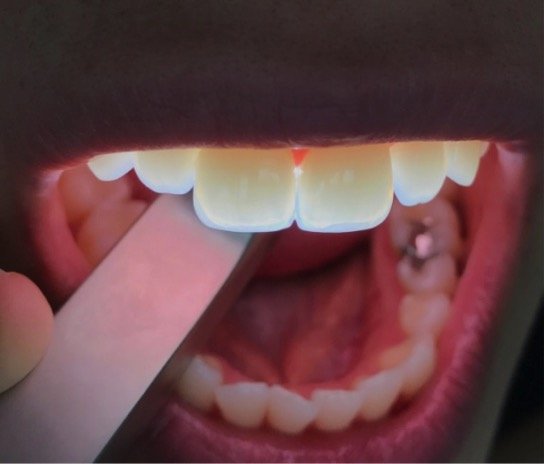How to Deal with a Cracked Tooth
I work as an emergency dentist near Runcorn, Brisbane. In my clinic, we often see patients who complain about an unpredictable and erratic sharp pain when they are chewing food or when their tooth is exposed to temperature extremes.
Their toothache comes and goes. It is sometimes elicited by biting and sometimes when they are releasing the pressure off the bite. The pain may also linger for a while after chewing food.
They go to their dentist and even their good and experienced dentist cannot find any issues in their X-ray images!
If you are experiencing the above symptoms and your teeth is non-carious, then you may have a cracked tooth or as well as we call it: a possible fraction. Technically, a cracked tooth is an incomplete fracture of the dentine in a vital tooth. The crack may or may not involve the pulp.
Very small fractures cannot be detected through an x-ray examination.
Why Cracked Tooth Causes Pain
The reason why you are experiencing pain is that when there is a crack in your tooth, pieces of the tooth along that crack line can slightly move under biting pressure or upon release of pressure. These movement of pieces is nearly imperceptible but can irritate the soft tissues of the tooth.
Movement of the cracked section at certain angles can cause severe sharp pain. The pain is usually initially sharp and localised but over time it can diffuse and be hard to localise. If infection develops in that tooth, it can become a localised pain again.
If you experience pain when you are releasing your bite, it may be associated with fluids that move towards the pulp within the dentinal tubules.
Some Causes of Tooth Cracks:
- Biting on hard objects e.g. cherry kernels, hard almond, pencil
- Bruxism
- Excessive use of pins in tooth restoration
- Excessive removal of tooth tissue for cavity prep
- Non-incremental application of composite
- Trauma
The lower back molars provide and absorb great biting force but if you are a type of person who enjoys biting on hard food e.g. nuts, ice, etc., then you may cause your teeth to crack!
The cracks could be still in the hard tissues of the tooth and in the area above the gum level. In this case, it may be a simple crack and most likely visible to your dentist. Simple crack is easy to detect and treat by either grinding or placing a dental crown. However, if the crack is left unnoticed it can spread and develop into a complex crack that involves the soft tissues of the tooth.
As the crack spreads to the soft tissues, you might become sensitive to extreme temperatures and the erratic irritation pain can begin. This irritation can lead to an infection in the soft tissues and if it is left untreated, it can spread to other surrounding tissues of the tooth including your gums or even the bone.
Challenges of Treating a Cracked Tooth
Sometimes cracks are very small and they may or may not be detectable through visual examination. Dentists who are well-equipped and use loupes have better chance in detecting cracks compared to other dentists.
Loupes provide magnification and sufficient lighting and a better chance for your dentist to find a crack in your tooth if it exists. However, not all tooth cracks are superficial cracks and finding some cracks is quite challenging. Some tooth cracks only become visible when an old restoration is removed.
X-ray images are not often useful for detecting cracks and small cracks do not appear in radiographic examinations because cracks often propagate in a mesio-distal direction which is in parallel with the x-ray film.
If the crack is suspected to be under a filling, removal of the filling may or may not reveal the crack. It is not guaranteed that the crack will be visually detectable after excavation of the existing filling.
How Dentists Detect Cracked Tooth
Some patients experience pain from a cracked tooth but they cannot precisely tell which tooth is causing the pain. In such cases, when the crack is not visually detectable, dentist may try different techniques to localise the cracked tooth. Usually methods below are used to find a tooth with a crack:
- Biting Test
- Firm Probing in Suspected Area
- X16 Magnification using a Microscope
- Asking the Patient to Bite on a Crack Finder
- Putting Pressure on the Suspected Cusps at Different Angles
- Placing a Fibre-Optic Light on the Tooth; Searching for Light Transmission Disruptions
- Using a Sharp Explorer and Scratching the Surface of the Tooth to See if its Tip Can Catch a Crack

Tooth Examination with a Light Source
The pressure tests are done to try to widen a crack if it exists so the associated pain can be mimicked and duplicated for identification of the tooth that has a crack in the dentine. When the tooth with the crack is identified then the dentists may put an orthodontic band around the tooth to hold its cracked pieces firmly together. If the symptoms disappear and the pain goes away, it would mean that the crack may be repairable with a permanent solution like a dental crown.
However, if the pain is not going away, then it means that the root canal is involved and a root canal therapy or extraction may be necessary.
Teeth crack in many ways and as such they may require different types of treatment. Crack may involve dentine and not pulp. Another type of crack may extend to the pulp but not the periodontal apparatus. Some cracks are treatable and some are unfortunately non-treatable. A crack that extends below your gum level for example is non-treatable.
A dental crown is a long-term solution for controlling a superficial crack. A superficial crack does not go all the way to the tooth nerve canal. When dentists find a superficial crack, some try to control it by a dental crown. The dental crown option is the safest option for the patient because cracks tend to grow within the tooth and a repair like grinding the crack is generally a only a temporary solution.
Conclusion
- Some cracks in the tooth may not be visible
- X-ray imaging cannot detect small cracks
- Some cracks are treatable and some are not treatable
- If the pain is not relieved with an orthodontic band or a temporary crown, then endodontic treatment or extraction of the tooth may be the only options.
- Expertise of a dentist is required for the treatment of pain associated with a cracked tooth.
Some Advice to Prevent Teeth from Cracking
- Avoid chewing on hard food: pen, hard nuts, bone, ice, etc
- Protect your teeth against grinding while you sleep (talk to your dentist)
- Use mouth guard if you play contact sports

Dr. Ellie Nadian is a registered dentist in Queensland, Australia. Her dental clinic, Pure Dentistry is in Brisbane Suburb of Upper Mt Gravatt and provides emergency dental services to Southside residents of Brisbane 7 Days a week. Phone (07) 3343 4869, Address: 11/1932-1974 Logan Rd, Upper Mount Gravatt, QLD 4122.
More to Read:
Previous Posts:





